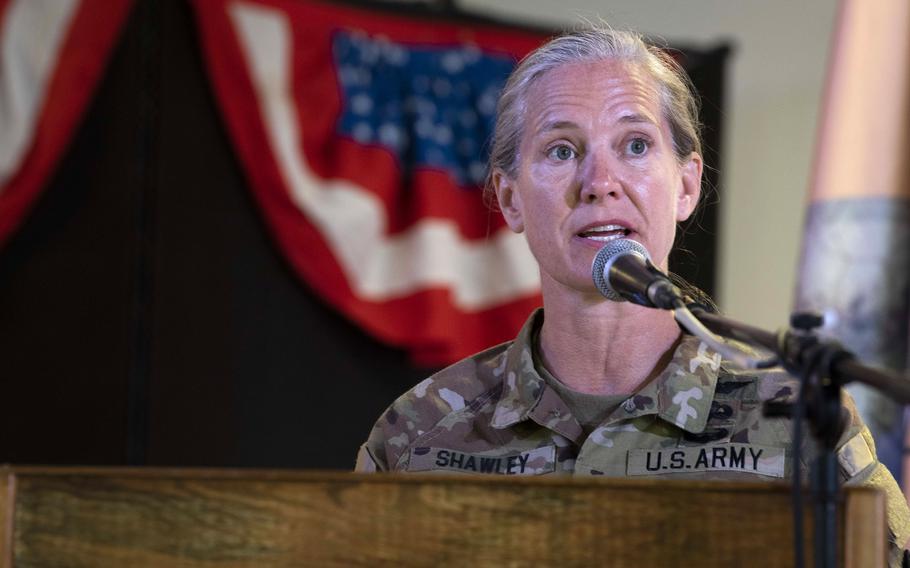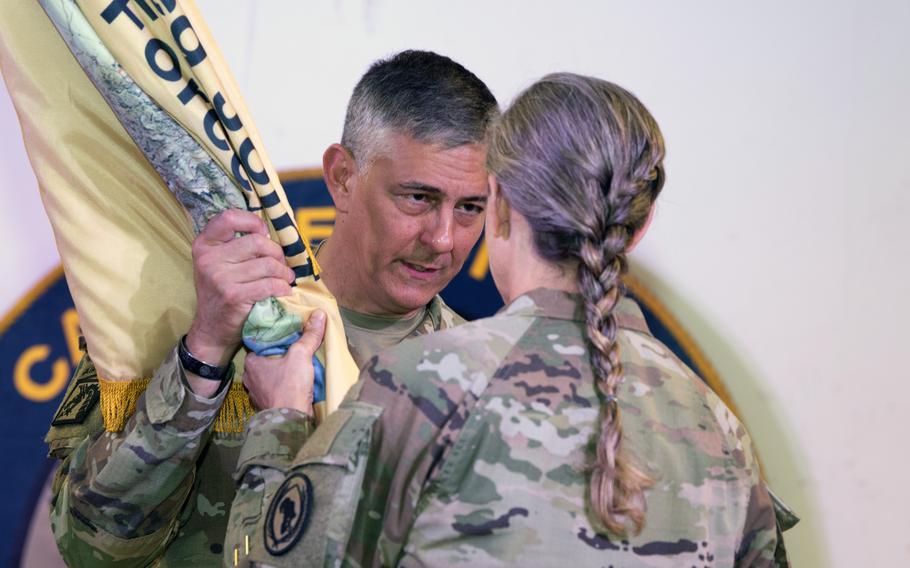
U.S. Army Maj. Gen. Jami Shawley, head of the Combined Joint Task Force-Horn of Africa, speaks after taking command at Camp Lemonnier, Djibouti, May 14, 2022. (Lynette Role/U.S. Air Force)
An Army two-star general is the first woman to take command of forces at the only permanent American military base in Africa, a milestone in the military’s 20-year mission in Djibouti.
Maj. Gen. Jami Shawley, a 1992 graduate of West Point, took over Saturday as head of Combined Joint Task Force-Horn of Africa, replacing Maj. Gen. William Zana.
U.S. Africa Command’s Gen. Stephen Townsend, who was on hand for the leadership change, said Shawley will be responsible for coordinating with partners to “maintain pressure on terrorists and other malign actors in this region."
Camp Lemonnier, the U.S. military’s main African hub, plays a key role in supporting counterterrorism efforts in neighboring Somalia.
Shawley said a key focus for her mission will be to work with an array of units that “enable us to provide crisis response, to support and protect our troops in Somalia and other locations.”
The leadership change comes as the U.S. looks for ways to keep the pressure on Somali militants aligned with al-Qaida.

Army Gen. Stephen Townsend, commander of U.S. Africa Command, transfers command of Combined Joint Task Force Horn of Africa to Army Maj. Gen. Jami Shawley at Camp Lemonnier, Djibouti, May 14, 2022. (Lynette Role/U.S. Air Force)
In late 2020, the U.S. withdrew about 700 troops from Somalia, and it has sharply reduced the number of airstrikes carried out in the country during the past year.
So far in 2022, AFRICOM has announced one airstrike against al-Shabab fighters. That took place in February and was its first strike in Somalia since August 2021.
Townsend told the Senate Armed Services Committee in March that this strategy change means U.S. forces are “commuting to work” in Somalia, where smaller rotations have “caused new challenges and risks for our troops.”
“I believe my assessment is that (the strategy) is not effective. … We are marching in place at best. We may be backsliding,” Townsend said.
The leadership change comes as the U.S. looks for ways to keep the pressure on Somali militants aligned with al-Qaida.
The New York Times on Monday reported that President Joe Biden will deploy hundreds of special operations troops to Somalia and also granted the Pentagon more authority to carry out airstrikes in the country.
In late 2020, the U.S. withdrew about 700 troops from Somalia, and it has sharply reduced the number of airstrikes carried out in the country during the past year.
For decades, the militant group known as al-Shabab has waged a campaign to overrun Somalia, which has a weak central government and a long history of disorder.
In recent years, the U.S. had stepped up its support of Somalia’s army with expanded training missions in the country and an airstrike campaign against militants.